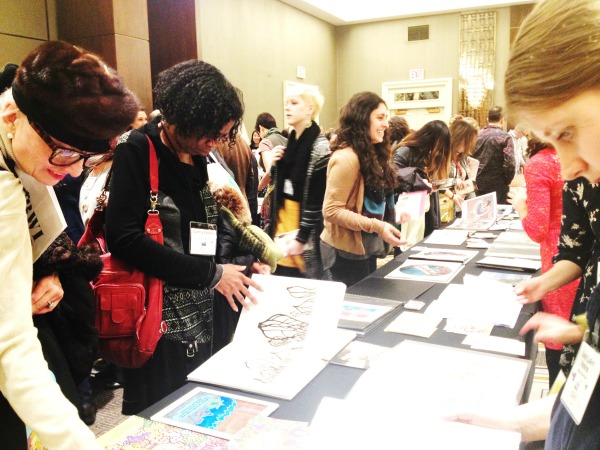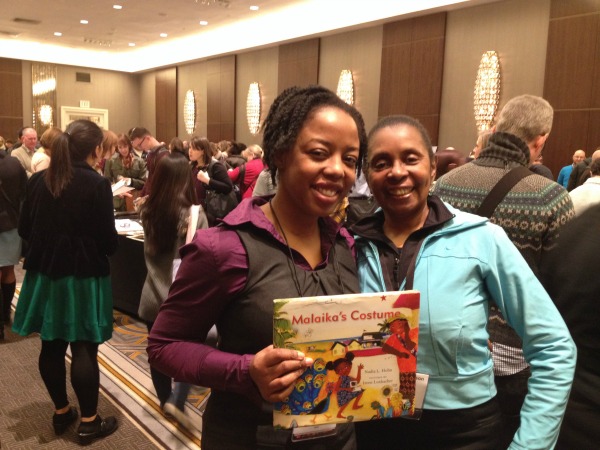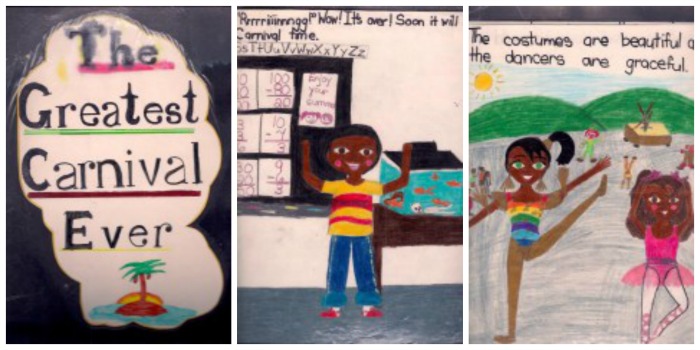Author Sighting: Nadia L. Hohn at 17th Annual SCBWI Conference
- Written by Luvon Roberson @LuvonRwriter
- Published in Author Sightings
 Photo Credit: Courtesy of Nadia L. Hohn on Twitter
Nadia L. Hohn, author of the children's book, Malaika's Costume
Photo Credit: Courtesy of Nadia L. Hohn on Twitter
Nadia L. Hohn, author of the children's book, Malaika's Costume
Nadia L. Hohn, author of Malaika's Costume, a book about immigration & Caribbean traditions, at Society of Children's Book Writers and Illustrators Conference
Was I drawn to it or did I just happen to wander into some irresistible secret place? That can't be true, I say to myself because this so-called secret place is crammed to the rafters with hundreds of people. And, it is buzzing with life, with people, who are lining up, leaning in, poring over – yes! Those are thousands of images, drawings, paintings, collages, all manner of color-drenched illustrations, displayed on dozens of tables, running through the room like ribbons plaited through a little black girl's braids. I've wandered into the Illustrators Ballroom.
 Illustrators Ballroom at the 17th Annual Society of Children's Book Writers and Illustrators Conference in New York City. Photo Credit: Luvon Roberson
Illustrators Ballroom at the 17th Annual Society of Children's Book Writers and Illustrators Conference in New York City. Photo Credit: Luvon Roberson
This space is one of my highlights at the Society of Children's Book Writers and Illustrators Conference. This is where I meet Nadia L. Hohn, who lets me know that she's an author as well as an illustrator, Canadian, and was born in and lives in Toronto, her parents hailing from Jamaica. She shows me her book, Malaika's Costume (Groundwood, 2016). I'm drawn in, once again, because it's the story of immigration.
 Photo (l to r): Nadia L. Hohn, author of Malaika's Costume; and Luvon Roberson, What's The 411, Book Editor. Photo Credit: Luvon Roberson
Photo (l to r): Nadia L. Hohn, author of Malaika's Costume; and Luvon Roberson, What's The 411, Book Editor. Photo Credit: Luvon Roberson
In reality, of course, the story of immigration is many stories, told in diverse voices, throughout human history. Today, with news headlines screaming and U.S. presidential candidates blaring anti-immigration rhetoric and crying out for walls to be erected, how refreshing that children can discover one of their voices about immigration in Malaika's Costume.
Vibrantly illustrated, with images and colors that summon the sights, smells, sounds, people and textures of life in the Caribbean, and written in an easy-to-follow, flowing Caribbean dialect, Malaika's Costume tells this story through little Malaika's search for a costume to wear at Carnival. The story is particularly poignant as it is Malaika's first Carnival without her mother, who has immigrated to Canada in search of a job with better wages, leaving Malaika back home in the Caribbean in the care of Malaika's grandmother.
In some ways, Malaika's Costume is familiar. My mother migrated from Mississippi to New York City, following her dream of a better life for her children. She left behind my sister and me for several years, with family members.
Malaika's Costume looks at some hard truths about immigration and a little girl's separation from her mother, and is a beautiful surprise to me: It is a picture book, for children, ages 3 to 7. In its gentle yet head-on look at loss, disappointment, resilience, and ultimately triumphant creativity, we see a little brown girl's learning more about herself as she seeks and finds resources in her community.
The benevolent tailor Mr. Chin gives heartbroken Malaika a bag filled with fabric scraps, and with her wise-in-Caribbean-traditions-and-family grandmother guiding her, Malaika transforms the scraps into a rainbow peacock costume. In the first Carnival without her mother, we see Malaika's dancing in her magnificent many-colored costume in joyful celebration of and with her community.
Post Script...
Author Nadia L. Hohn informed me that the seeds for Malaika's Costume have many roots. In her blog, she says: "As a child, I used to write and illustrate picture books. One of the few I still have today is called, The Greatest Carnival Ever."

Malaika's Costume is author Nadia L. Hohn's first picture book. She is currently writing the sequel. Irene Luxbacher, an award-winning Canadian illustrator, brings color-drenched images to life in Malaika's Costume via collage-inspired design.
In my next "BOOKish blog," you will meet two illustrators-writers, Heidi Woodward Sheffield, and Mischa Kuczynski, in the fourth of my five-part series on the 2016 SCWBI Conference in New York City. The previous two stories in this series are SCBWI Executive Director Lin Oliver's call for diverse books and a feature story on acclaimed illustrator James Ransome.


